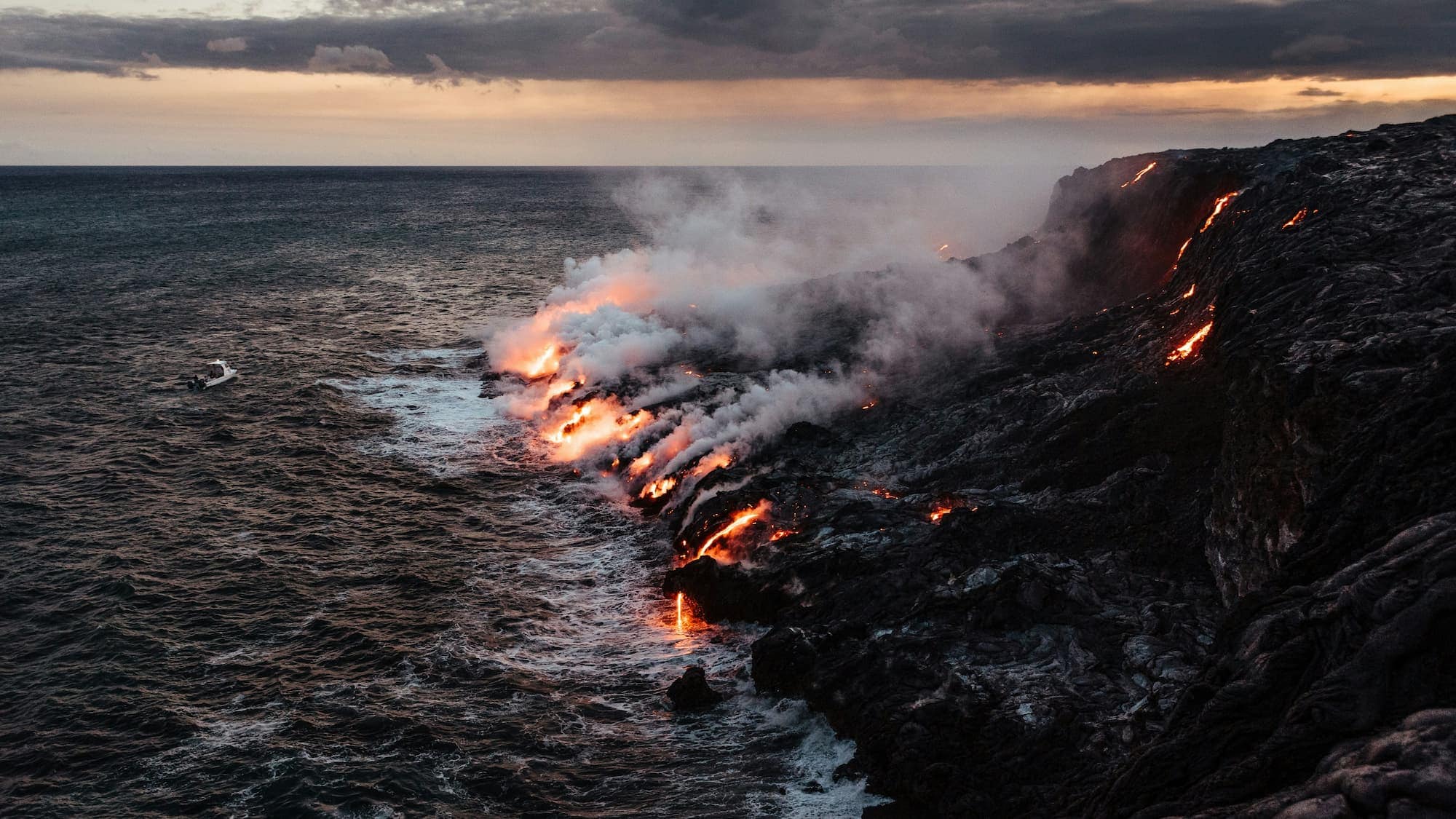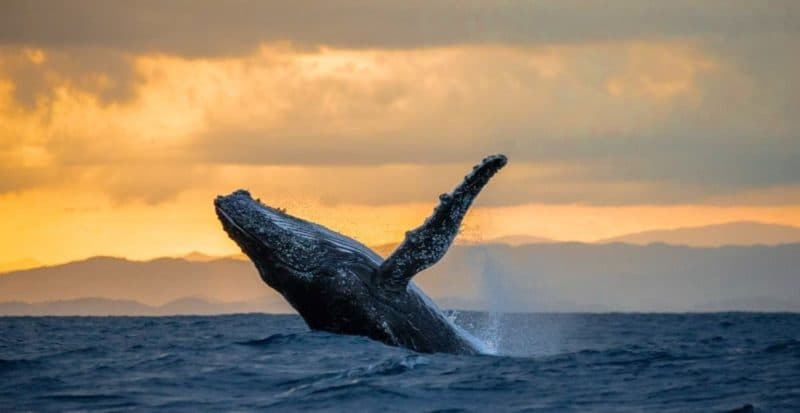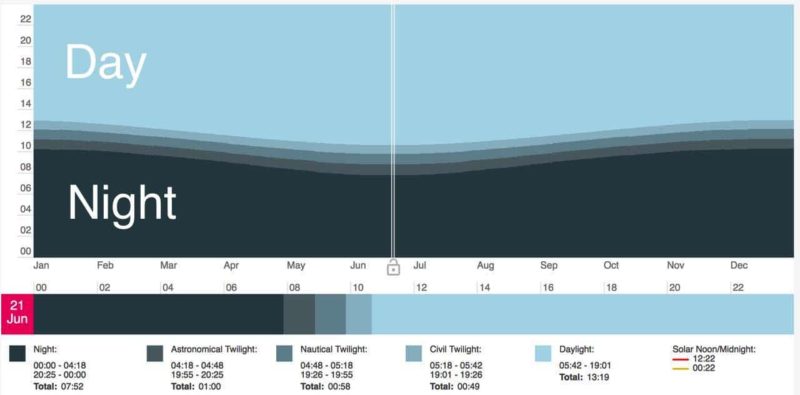Deciding to travel to the Big Island on vacation is an easy decision; deciding when to travel to the Big Island is the more interesting part. What’s the best time of year in the islands? Is winter all that much different than summer? Are there certain activities that are seasonal? Is there a high and low season?
Personal schedules aside, there are many questions that need to be addressed. And the answers depend highly upon your goals as a traveler and how you plan to experience the islands. Below, we run through the basic things to know about different times of year on the Big Island, as well as the best times to visit for various popular activities. We also explain the general weather patterns in Hawaiʻi and give advice on how to handle the rainy season.
Table of contents
- Why visit?
- What is the best time to visit the Big Island:
- Seasonal weather trends: a month-by-month breakdown for the Big Island
- How to avoid rain during the rainy season on Big Island.
Table of Contents
- Why visit?
- What is the best time to visit the Big Island:
- Seasonal weather trends: a month-by-month breakdown for the Big Island
- How to avoid rain during the rainy season on Big Island.
Why Visit the Big Island?
The Big Island lives up to its name in stature – its landmass is larger than all of the other islands combined. In this way, traveling to the Big Island is different than any other island simply due to the amount of area there is to explore.
Its environmental diversity is impressive, home to 8 of the world’s 13 climate zones. On a visit, you can taste fresh Kona coffee in the morning, stand amongst the snow atop Mauna Kea at nearly 14,000 feet in the afternoon, and then explore white, black, and green sand beaches at sea level at sunset. The island is home to five volcanoes, including Kīlauea, one of the world’s most active volcanoes, as well as many historical and cultural sites.
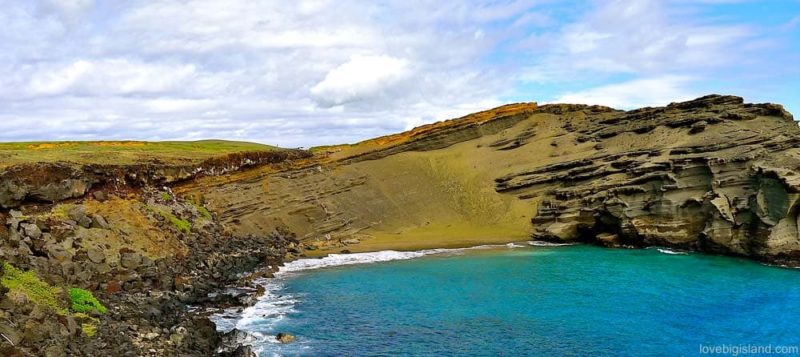
Green Sand Beach (Papakolea) on the Big Island is one of only two green sand beaches in the United States.
What is the best time to visit the Big Island?
To the foreign observer, summer and winter are not as dramatically different in Hawaiʻi as they are in most other places. While that’s true, it is important to understand that the islands do experience impactful seasonal fluctuations that have a real effect on the mood, energy, and opportunities on the island, both on land and in the ocean. The idea that Hawaiʻi is the same all year round is not true, and understanding the differences will help you decide the best time to visit.
The question “What’s the best time of year to visit the Big Island?” can only be answered with a flurry of more questions. The best time to visit depends on what you want to do while visiting, as some activities are more impacted by the seasons than others. Cost also comes into play, with certain times of year being more expensive.
To help you figure out the best time to visit Big Island, we explain how the seasons effect different types of popular activities on the Big Island below.
- for the beaches?
- to see whales?
- for snorkeling?
- for the volcanoes?
- “on the cheap?”
- to skip the crowds?
- for the weather?
What is the best time to visit the Big Island for the beaches?
If you’re a beach bum, then spring, summer, and fall are the best times to visit the Big Island, with summer being the best choice overall for long, sunny days in the sand. You can certainly still have a nice sunny day during the winter months; however, the sunny days are not as consistent and you increase your chances of rainy weather. For the best chance at the most consistent “beach weather,” go between May and October.
- Check out our list of beaches on the Big Island to start planning.
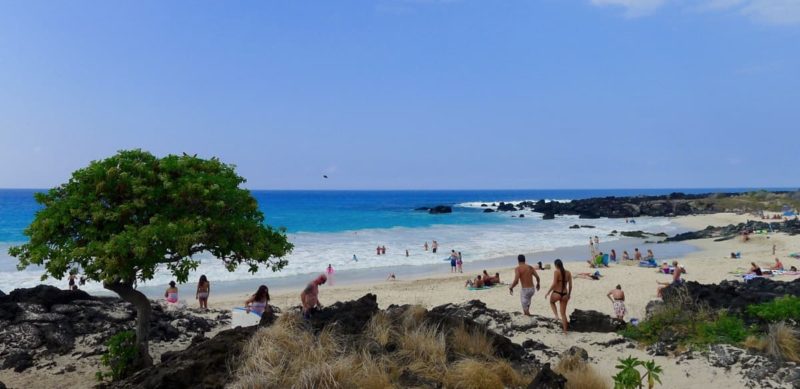
Kua bay beach is one of our favorite Big Island beaches.
What is the best time to visit the Big Island to see whales?
Whale season runs during the winter months, from November until the end of March. This is the only time frame you can see humpback whales in the islands, and it’s also when you will find whale watching tours operating every day. January, February and March tend to be the peak months for whales.
- Have a look at out complete guide to whale watching on the Big Island (DIY and boat tours) for a deep dive.
What is the best time to visit the Big Island for snorkeling?
The best time of year for snorkeling on the Big Island is spring, summer, and fall. But it’s possible in winter too.
Snorkeling can be done all year round on the Big Island, and it can also be made difficult any time of year on certain days, with swells and storms stirring things up from time to time. That said, the winter months are when the likelihood of storms and swells are higher.
So, if you have your heart set on multiple days of snorkeling in multiple places, you should plan for the summer months, just to be safe. If you want to snorkel maybe once or twice and aren’t too particular about it, you can feel free to go any time of year.
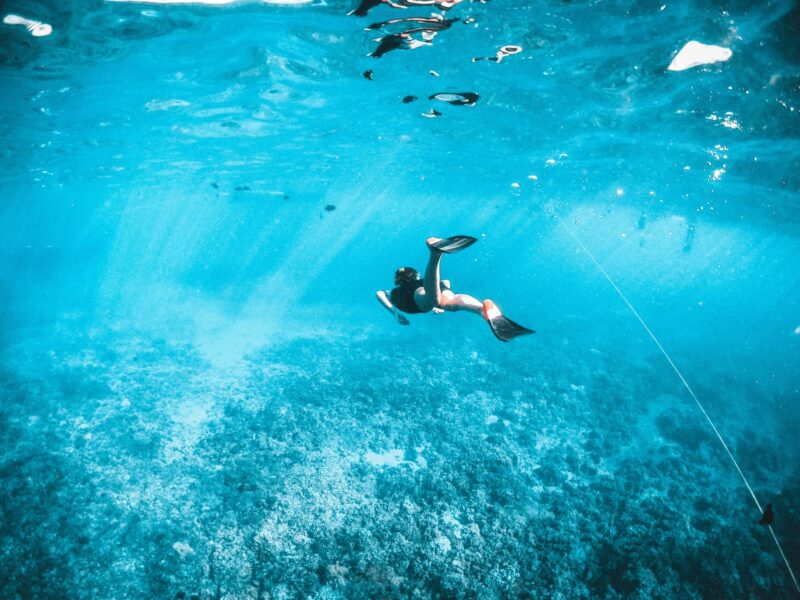
Choose the summer months for your visit if snorkeling is the main focus of your visit to the Big Island. Photo by Subtle Cinematics on Unsplash.
Here are a few resources to start planning your snorkeling trip:
- Our 3 favorite snorkeling spots on the Big Island
- The best snorkeling spots for beginners
- the 14 best snorkeling spots on the Kona Coast
- and our overview article about snorkeling on the Big Island
What is the best time to visit the Big Island for the volcanoes?
Nothing in the seasons will affect the activity of the volcanoes on the Big Island. They erupt (or don’t erupt) in winter just the same as they do in summer, and there is no data to support that eruptions are more likely at certain times of the year.
The thing to keep in mind about volcanoes and the seasons is the weather at the summits. Kīlauea’s summit is located in Hawaiʻi Volcanoes National Park at 4,000 feet above sea level, while the summit of Mauna Kea is about 13,800 feet. During winter, these areas will be cooler, and in the case of the latter, access might be disrupted by snow and ice. (That said, a cool winter day at Kīlauea can be absolutely perfect for hiking the lava fields, which get quite hot in the summer.)
There will be, however, more variable weather patterns in winter, and a higher chance of rain and wind. For those wanting to visit the summit of Mauna Kea and do some stargazing, spring, summer, and fall are the best options.
- See our guide on how to see lava on the Big Island for planning details.
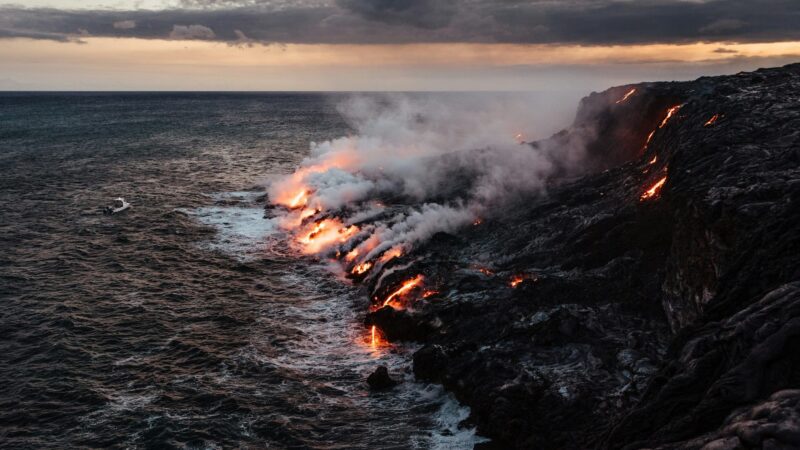
If one of the volcanoes is erupting you should definitely set some time apart to see the lava. Image by Cedric Letsch on Unsplash.
What is the best time to visit the Big Island for hiking?
Each season in Hawaiʻi brings about different opportunities for hiking.
Winter: Coolest temperatures, great for exploring coastal lava fields. Cold temperatures at higher elevations could make certain hikes undesirable, such as the summit area of Mauna Loa.
Spring: Wonderful time to explore the rainforests, after winter rain has bulked up the waterfalls.
Summer: Best time to explore high elevations. Rainforests, summit areas, and forest hikes provide lots of shade during hot days. Hikes without shade, such as coastal lava fields, may be uncomfortably hot.
Fall: Cooler, typically dry weather make hiking pleasant just about anywhere. Higher elevations may require a bit more gear due to dropping temperatures.
- Walk through our 5 favorite short hikes on the Big Island as warm-up.
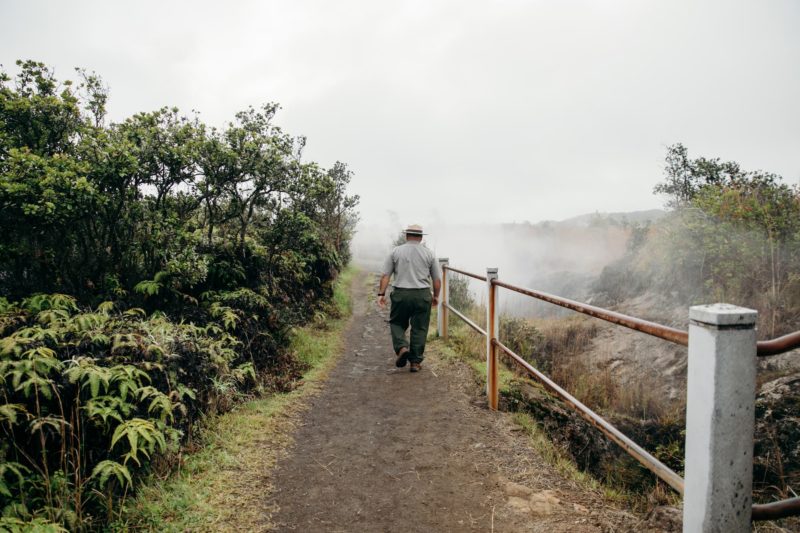
Rain or shine, there are many great hiking opportunities in the Hawaii Volcanoes National Park. Hawaii Tourism Authority (HTA) / Heather Goodman / @hbgoodie
What is the best time to visit the Big Island “on the cheap?”
Generally speaking, the cost of accommodations on the Big Island is the lowest in the shoulder seasons and highest in the summer.
The main exception to this general rule is the holiday season, starting at Thanksgiving and going through the New Year. These times of year tend to be more expensive due to holiday travel.
Otherwise, you can expect the summer months to have the highest rates, and months like January and February to be the most affordable.
Of course, keep in mind that the Big Island has limited accommodation options compared to, say, Oʻahu, so one cannot expect an overly dramatic shift in prices, especially in the most popular areas, such as downtown Kailua-Kona.
Save some money with our following guides:
- See our guide to on where to stay on the Kona Coast for ANY budget for a deep-dive in finding your perfect accommodations on the Kona coast.
- Give your wallet a break with our list of free and cheap things to do on the Big Island
- Another good read is our guide titled “6 Ways to Save Money when Planning a Trip to Hawaiʻi“.
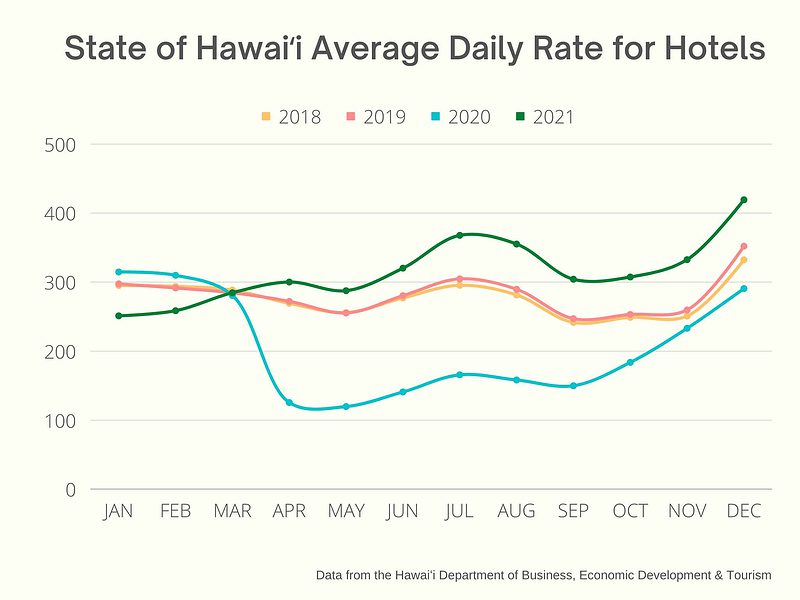
This comparison of the monthly average daily rate hotels in the state of Hawaiʻi shows that the shoulder seasons are the best time to find an affordable hotel room.
What is the best time to visit the Big Island if you want to skip the crowds?
The least crowded times on the Big Island usually follow the school calendar. The summer months are always the busiest, with January, February, September, October, and November seeing the lowest visitation. March and April go back and forth – some weeks are chill, others are busy due to spring break. Holiday travel usually provides an uptick in visitors in December.
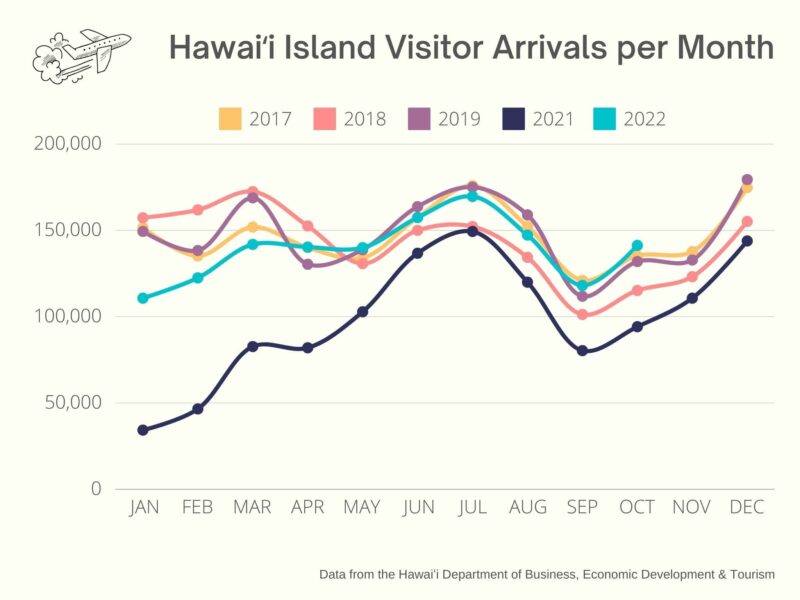
Big Island visitor arrivals per months for the period from 2017 up to 2022. We omitted 2020 because the severe COVID travel restrictions heavily skew the numbers for that year. September through November are the quietest months, while summertime and December are the most crowded.
